Environment
A Strong Commitment Backed by Action
“Our environment is part of us.
How we care for our environment
and live with it, utilize it and enjoy it
determines the kind of people we are and will be.”
-Laurance S. Rockefeller
Protecting Open Space and the Environment through Strategic Plan Initiatives
The Glenview Park District Strategic Plan contains numerous environment-related initiatives which include:
- Identifying environmental impacts at each facility and developing plans to reduce these impacts
- Developing staff training on environmental topics and green purchasing expectations
- Setting and implementing standards to purchase recycled products and eco-friendly alternatives
- Improving efficiencies in the purchase of energy and resources
- Incorporating Natural Resources Management Plans into overall Parks Master Plan
- Developing and implementing additional environmental education programs for schools and families
Read our Environmental Sustainability Plan for specific information about how we plan to protect our land and our environment for the future.
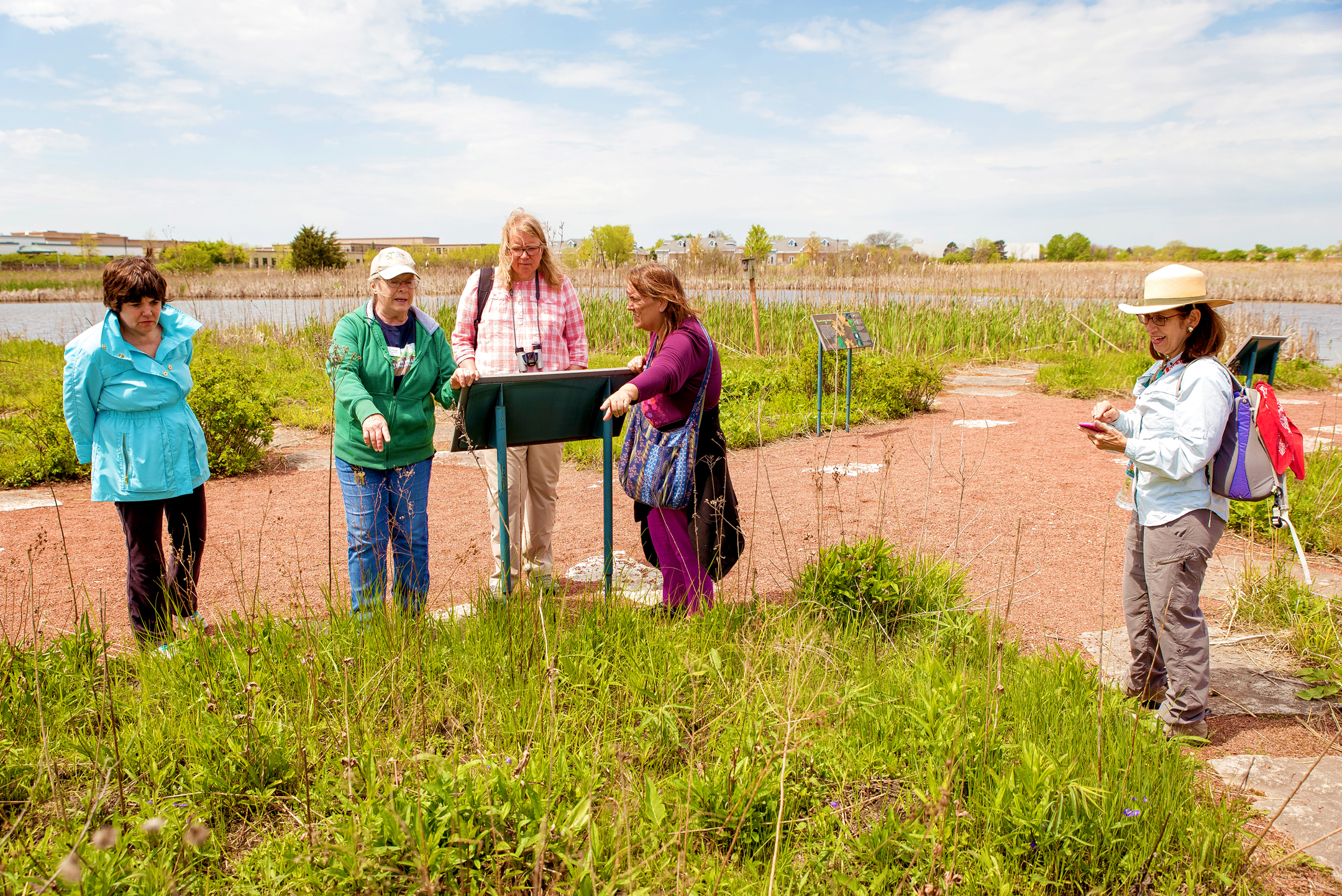
- The Evelyn Pease Tyner Center and Kent Fuller Air Station Prairie, an L.E.E.D. Platinum building and tallgrass prairie built by the Village of Glenview
- The Grove, a 151-acre nature preserve with an extensive Interpretive Center dedicated to natural history and environmental education
- Assumed management and maintenance in 2010 of approximately 60 acres of the Village of Glenview’s Gallery Park, an area which includes wetland and natural restoration areas
- Expanding schedule of environmental education programs being offered at Air Station Prairie and The Grove including “Going Green,” practical information on how you can incorporate “green” technology into your home
- Environmental Education Supervisor and staff work to expand environmental programming and community outreach
- Provided opportunities for citizens to learn about and preserve the environment through Work Days at Air Station Prairie and The Grove (To find out more about these, please click on links at the top of this page)
- Joined with local school districts, Village, Library, Chamber of Commerce, Glenbrook Hospital and the Solid Waste Agency of Northern Cook County to form Go Green Glenview, a community-wide public education campaign designed to raise awareness about local resources that make it easier for residents to go green–and to provide tools to help out
To build environmental awareness within the park district and the community, in 2008 the Glenview Park District formed a park district Environmental Team composed of representatives from facilities throughout the district. Team responsibilities include:
- Reviewing, evaluating and recommending district-wide environmental policies
- Creating and implementing an Environmental Management System
- Planning, organizing and conducting training on environmental issues
- Assisting in the evaluation of the cost-effectiveness of the district’s environmental initiatives
In keeping with the Glenview Park District commitment to the environment, a number of environmentally important practices have been identified for implementation. These include:
- Use of sustainable energy
- Biodiversity protection
- Natural area restoration
- Carbon footprint reduction
- Raising public awareness through programs and events
- Reduction of pesticide/fertilizer use
- Use of recycled products
- Partnerships with other agencies through Chicago Wilderness Consortium
- Reduction of use of landfill space through District-wide recycling
We invite you to join us in preserving our environment for the generations to follow.
The Glenview Park District is committed to providing its services in a manner that meets the needs of the community while sustaining and protecting the environment. This will be accomplished through:
- Pollution prevention
- Energy and water conservation
- Resource sustainability
- Natural area enhancement
- Invasive species management
- Partnerships with other agencies
- Community outreach and educational programming
- Complying with or exceeding environmental regulations
To achieve these goals, the Glenview Park District has implemented an Environmental Management System (EMS) that promotes environmental awareness to both employees and residents and aids in the continuous improvement of environmental performance.
This Policy will apply to all Glenview Park District employees, volunteers, contractors, and vendors.
Do No Harm
Make no changes that will degrade the surrounding environment. Promote projects that occur where there has been previous disturbance or development that presents an opportunity to regenerate ecosystem services through sustainable design.
Precautionary Principle
Be cautious in making decisions that could create risk to human and environmental health. Some actions can cause irreversible damage. Examine a full range of alternatives—including no action—and be open to input from all affected parties.
Design with Nature and Culture
Create and implement designs that are responsive to economic, environmental, and cultural conditions with respect to the local, regional, and global context.
Use a Decision-Making Hierarchy of Preservation, Conservation, and Regeneration
Maximize and mimic the benefits of ecosystem services by preserving existing environmental features, conserving resources in a sustainable manner, and regenerating lost or damaged ecosystem services.
Provide Regenerative Systems as Intergenerational Equity
Provide future generations with a sustainable environment supported by regenerative systems and endowed with regenerative resources.
Support a Living Process
Continuously re-evaluate assumptions and values and adapt to demographic and environmental change.
Use a Systems Thinking Approach
Understand and value the relationships in an ecosystem and use an approach that reflects and sustains ecosystem services; re-establish the integral and essential relationship between natural processes and human activity.
Use a Collaborative and Ethical Approach
Encourage direct and open communication among employees, patrons, contractors and vendors to link long-term sustainability with ethical responsibility.
Maintain Integrity in Leadership and Research
Implement transparent and participatory leadership, develop research with technical rigor, and communicate new findings in a clear, consistent, and timely manner.
Adopted by the Glenview Park Board of Commissioners, August 28, 2008. Adapted from: The Sustainable Sites Initiative, 2007 “Preliminary Report on the Standards and Guidelines.”
Glenview Park District Green Initiatives
In 2025 the Glenview Park District officially adopted its first-ever Environmental Sustainability Plan—a milestone achievement that marks a renewed and focused commitment to preserving the natural beauty of our community for generations to come. The plan was developed by the Park District’s Environmental Team in collaboration with Wight & Company, a design, architecture and planning firm with a focus on sustainability.
This plan isn’t just about planting more trees (although we’re doing that too!). It’s a comprehensive guide that weaves sustainable thinking into nearly every facet of Park District operations—from land management and facility upgrades to community education and daily operations. View the plan.

In Spring 2024, the Glenview Park District introduced a new solar trailer to the community. The trailer includes solar panels on the roof that power its electric landscaping equipment and features a special wrap design that highlights this renewable energy resource. Thank you to Weiss Ace Hardware and EGO for their support of this green initiative.

In 2020, the Glenview Park District, in conjunction with Graf Tree Care of Batavia, Illinois, developed a comprehensive Urban Forest Management Plan (UFMP). This tailored plan will guide the district in creating and maintaining a more robust, diverse, and resilient tree population within our park system for the next 30 years. The Glenview Park District currently cares for and manages more than 10,000 trees in addition to the inventory at The Grove. Increasing the number of trees in our community and caring for them long-term are essential to our economy, safety and personal well-being. To view the Urban Forest Management Plan, click here.
The UDMP was made possible thanks to a $3,000 Urban and Community Forestry Grant from the U.S. Forest Service, which the Park District matched in-kind. The program is administered by the Morton Arboretum in partnership with the Illinois Department of Natural Resources.
The Glenview Park District bans the use of coal tar sealcoats in any pavement projects performed by staff or contractors. Coal tar seal coats contain chemicals which have been classified as a reasonably aniticipated human carcinogen. While the park district has banned the use of this type of sealcoat for many years, the policy was officially adopted in 2017. To read a fuller description of this policy, click here.
In 2012, the Glenview Park District adopted a policy to discourage employees and patrons in diesel and gasoline powered vehicles from idling for excessive periods of time near park district facilities in order to improve air quality. To read a fuller description of this policy, click here.
In an effort to minimize impacts to the environment, the Glenview Park District has adopted an Integrated Pest Management system to help us reduce chemical usage in our parks and facilities. As a result of using less pesticide in these areas, weeds such as dandelions may be apparent for a short time each spring.
Our crews mow the lawn areas regularly to control weeds. We also follow lawn care recommendations to keep grass three to four inches high to allow for strong root growth and some shading out of weeds. However, because of our limited use of chemical pesticides, weeds such as dandelions grow back very quickly.
Remember that these dandelions are a sign of our Integrated Pest Management system at work and an indication of a healthy and safe environment for you and your family.
In addition to housing educational exhibits about the prairie, the Evelyn Pease Tyner Interpretive Center at Air Station Prairie, 2400 Compass Road, is a showcase for “green technology.” The building features a number of environmentally sound design attributes including a geothermal heating and cooling system, solar energy panels, and a “green roof”. The Tyner Center has been certified by the U. S. Green Building Council as LEED Platinum, the highest possible designation under the Leadership in Energy and Environmental Design rating system.
A U.S. Department of the Interior National Historic Landmark, The Grove is comprised of ecologically diverse land, including oak woodlands, wetlands, prairie and many varieties of flora and fauna. In order to maintain a healthy ecosystem, invasive plants are removed. This allows for the native plants to flourish, attracting critical pollinators, birds and wildlife.
In developing the master plan for the development of the second phase of Community Park West which was completed in 2010, a primary consideration was to design a park which not only met the recreational needs of the community but could also serve as a model of native plant species and wetlands preservation. Careful attention was paid to management of storm and ground water to minimize the impact on our water supply and the planting plan for the park includes native trees and shrubs adapted to the specific conditions of each planting location.
The new Park Services facility at the southwest corner of Community Park West which opened in April 2010 included a number of “green” features including low energy lighting, geothermal heating and cooling, occupancy sensors to turn off lights when no one is in a room, reflective pavement to reduce heat buildup in the yard, a cistern to collect water off the facility roof, rain gardens and biowswales to slow rain run-off and enable more water to be absorbed into the ground, native low-maintenance landscaping and a porous pavement demonstration area. A green roof, funded by the Department of Commerce and Economic Opportunity Recovery and Reinvestment Act Green Roofs program Grant, was also installed. In September 2010, this new facility was recognized with an Illinois Association of Park Districts Best Green Practices award.
Zero Waste is an effort to reduce the amount of trash generated in the parks. We are asking park patrons that whatever you bring into a park, plan to bring it back out.
Use reusable items, including:
- Reusable drinking bottles (water refilling stations in the park)
- Bring food in containers
- Bring silverware and napkins
- Reusable bags for your supplies
- Avoid one-time use items and disposing of them in the park
The “No Mow” Naturalized Areas initiative is where the Park District has identified select areas in parks that are prone to holding water, or underused, that will not be mowed during the season. Naturalized Areas provide several benefits including:
- Improving air quality by eliminating exhaust pollutants
- Reducing stormwater runoff & encourage infiltration
- Providing habitat for pollinators & grassland birds
- Cost savings by reducing gas usage, fertilizer, & staff time
- Filtering out pollutants and improving the overall water quality
No Mow doesn’t mean No Maintenance. The perimeter of these areas will be mowed to define the bed edge and indicate that the area is intentional. Naturalized areas will receive an annual mowing after the growing season has ended. We will continue to monitor the grounds, and make any adjustments as necessary.
For the past several years, the Glenview Park District has cooperated with the Village of Glenview in a Christmas tree recycling program to reduce the number of trees being sent to landfills. The trees are picked up by Village trucks then ground up by park district workers to be used as mulch in the parks. This program recycles an average of 3,300 Christmas trees per year.
We continue to look for ways to reduce our energy consumption with more efficient products and practices including:
- LED Lighting Conversions at the Park Center gyms and the Tennis Club indoor courts. Not only are there savings in using less energy, but there are also reduced maintenance costs because these bulbs last much longer, and don’t need to be changed as often.
- LED sports field lighting at the Flick Park baseball, soccer, and sand volleyball courts.
- Solar Lighting at the Grove
- Occupancy light sensors at the facilities
- All of the park fieldhouses have been updated with Energy Star mechanicals and appliances, as well as spray foam insulation
- Reforestation efforts to replace the trees impacted by the Emerald Ash Borer
- Removal of invasive plants such as Phragmites and Buckthorn
- Negotiated construction of a berm adjacent to the Illinois State Tollway as part of a Tollway construction project to protect The Grove from noise pollution
- Land acquisition of parcels adjacent to The Grove to add to the nature preserve.
- Hired a dedicated Natural Resources Manager at The Grove to oversee all land management and restoration efforts.
We want to be responsible to those using the parks, as well as our staff in reducing their exposure to chemicals and pollutants.
- Liquid Propane riding mowers to eliminate exhaust
- Electric Ice Edger for the Ice Center
- Spray hood for the Golf Club maintenance
- Installed water bottle filler drinking fountains in the parks and at the facilities so users can re-fill their own, and eliminate single-use plastic bottles.
- Ceramic Clay Roller to re-use clay for art classes
- Tennis ball pressurizer at the Tennis Club to re-use balls
- Porous concrete sidewalk installations at Sleepy Hollow, Judy Beck, and Landendorf Parks
- Working with the Village on storm water management projects, including the Park Golf Club
- Rain Garden installations at several parks
- Participated in World Wildlife Fund’s “Earth Hour” campaign each year to save energy and promote environmental awareness
- Conducted recycling and environmental education to all Glenview Park District campers
- Worked with the district’s marketing team to develop environmental messages and communicate them to our patrons through web-based and printed material
- Conducted public workshops to educate residents about the Emerald Ash Borer
- Participated in Earth Day celebrations at Air Station Prairie each year with environmental information, programs and activities
- Formed the Glenview Nature Network to inform community members about local stewardship opportunities
- Participated in “America Recycles Day” annually, with environmental programs, activities and the Nike ‘Re-use a Shoe’ campaign
- Conducted annual free Family Nature Scavenger Hunt program for families in conjunction with the Leave No Child Inside campaign
- Participated in Baby Steps Program–recycling/tree planting cooperative effort with School District 34 and local PTAs
- Together with 11 League of Women’s Voters groups co-sponsored “Our Climate Matters,” a four-day symposium on global warming and ways people can protect and preserve the environment.
- Provided opportunities for citizens to learn about, and preserve, the environment through Work Days at Air Station Prairie and The Grove.
- Provided input to the Village of Glenview’s Natural Resource Commission regarding “A Plan for Nature in Glenview” and other issues
- Worked with Village of Glenview staff in combating the Emerald Ash Borer and providing information to residents
- Moved forward with environmental marketing in conjunction with the Glenview Communicators Group’s “Go Green Glenview” program
- Formed partnership with Illinois Park and Recreation Association’s Environmental Team in areas of environmental education and natural area management
- Approached Park District Risk Management Association with the concept of adding “green” initiatives to their risk management auditing process
- Joined the national “No Child Left Inside” coalition and our local Chicago Wilderness campaign “Leave no Child Inside.”
- Partnered with REI for environmental programming equipment, education, and project funding opportunities
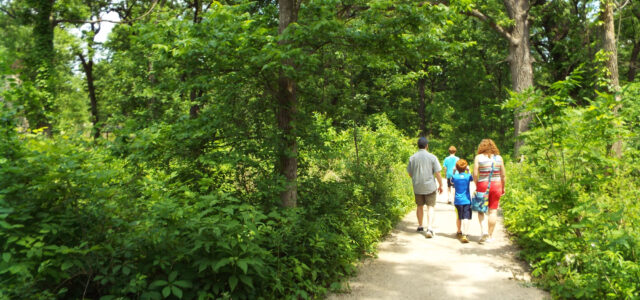
Leave No Child Inside
To help reverse the growing disconnection between children and nature, The Glenview Park District, along with Chicago Wilderness and more than 200 organizations, are working together to promote “Leave No Child Inside”. Spearheading the park district’s efforts is Lorin Ottlinger, Director of The Grove and the team leader of the Glenview Park District’s Environmental Team. Lorin’s passion for the Leave No Child Inside initiative grew from the experiences she had as a child, spending lots of time in the woods with her family, camping, fishing and hiking. She talks about what most people instinctively know: enjoying the outdoors with your children is fun, healthy and a great way to spend quality time with your family.

The movement was inspired by author Richard Louv, who in his groundbreaking 2006 book Last Child in the Woods: Saving Our Children from Nature Deficit Disorder, cited kids’ lack of direct experience with nature is largely to blame for alarming increases in obesity, attention deficit disorder and poor social skills. With Leave No Child Inside , our goal is to promote children’s health through outdoor play and exploration, and foster caring for nature and the environment in today’s children and future generations.
Every year, a smaller percentage of Americans are engaging in nature-based activities. Kids are so plugged into television and video games that they’ve lost their connection to the natural world. Children benefit from time in nature outdoors! As The Grove’s director, I see the results firsthand. Even if it’s just exploring in the backyard or at the park down the street, the outdoors provide an opportunity to engage all your senses — see, hear, touch, taste and feel — in a way electronics can’t. Kids who are exposed to nature early and often usually are more aware, have higher energy levels and increased levels of self-confidence. The evidence of needing nature for healthy childhood development is far more than just anecdotal.
One of the greatest gifts parents can give to their children is to share their love of nature. Consider efforts to get your children hooked on nature as an investment in your family’s health. Turn off the blackberry, put away the wallet and get outside! Getting involved is not as difficult as you might imagine. There are an abundance of simple, accessible, and magical outdoor places right here in the Glenview Park District. They’re as close as your neighborhood park. Simply being able to play freely, in a safe place, in the out-of-doors, and on a regular basis is where it all begins.
There are a variety of programs at The Grove, Air Station Prairie and Wagner Farm that do a great job of connecting participants with nature and our environmental and cultural heritage. Beyond that, there are over 13 miles of walking/bicycling paths through parks and trails that explore our diverse natural areas from tall grass prairies to oak-hickory savannas and wetlands; numerous sports fields and outdoor tennis courts; outdoor sled hills; and Community Bark West dog park. Even playing golf provides an opportunity to get outside and connect with nature!
Attend a nature program together or visit a neighborhood park. Skip stones across the water, count butterflies, or go fishing. For more ideas on where to go and what to do outside with your kids, click here.
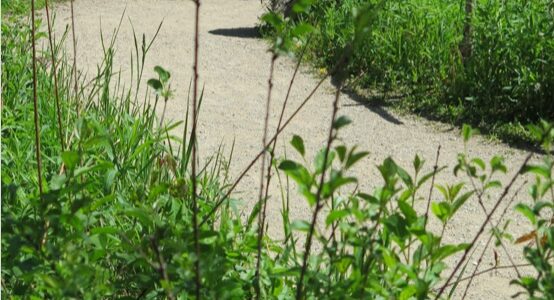
Go Green Glenview
Go Green Glenview is a community-wide public education campaign designed to raise awareness about local resources that make it easier for residents to go green–and to provide tools to help out. Go Green Glenview partners include Glenbrook High School District 225, Glenbrook Hospital, the Glenview Chamber of Commerce, the Glenview Park District, the Glenview Public Library, Glenview School District 34, Northbrook/Glenview School District 30, the Solid Waste Agency of Northern Cook County, the Village of Glenview and West Northfield School District 31.

What else can I do?
The chances for success of any efforts to preserve and protect the environment grow as more people get involved. Go Green Glenview has compiled an extensive list of places where you can recycle numerous items. Click here for more information.
has many suggestions for ways you can help. To find out more, click here.
Glenview residents can help our local environment by planting a rain garden in their yard. Rain gardens reduce the amount of water conveyed into the local storm water system. The vegetation in a rain garden filters the water, reducing pollutants that can end up in our natural waterways. The Village of Glenview currently has a program to partially reimburse residents for costs involved in planting a rain garden. For details on this program, click here.
Look for opportunities to install LED lighting.
Are you considering adding a tree to your landscape? It’s a great way to improve the beauty and functionality of your home environment, and the Village of Glenview can help! Launched in 2022, the tree planting incentive program provides a 50 percent reimbursement- up to $300- for pre-approved tree planting projects. For details on this program, click here.
Critter Guide
Over the past few years, an increasing number of coyotes have been spotted in urban areas including Chicago and the North Shore. While spotting a coyote in the Glenview area is rare, the image below showing the difference between the footprints of a coyote and of a domestic dog may be helpful to residents in detecting the presence of a coyote on their property.
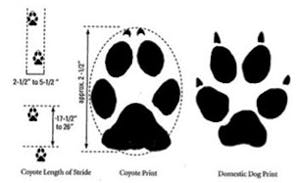
The red-winged blackbird is one of the most common and abundant birds in North America. They are fierce defenders of their nests, harassing all those that come close. Though smaller than the American robin, the red-winged black bird will think nothing of harassing hawks, crows and other large birds that pass over and will commonly escort humans away by hovering close and making angry calls.
The red-winged blackbirds can be found throughout the Glenview community and have reported to exhibit aggressive behavior in certain areas of the Glenview Park Golf Club, Flick Park, and Community Park West. Signs are posted in several of these areas warning visitors of the presence of red-winged nests.
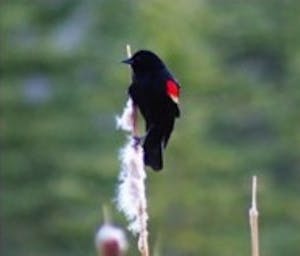
For the past fifty years the giant Canada goose population has been thriving thanks mostly to the successful efforts of fish and wildlife agencies to restore their populations. The giant Canada, most commonly seen in the Chicago-land area is the largest type of Canada goose.

General Information
- The giant Canada goose is perfectly happy in urban and suburban areas. Expansive golf courses, neatly mowed lawns, business parks and recreational fields many dotted with ponds, lakes, and water reserves are perfect nesting area.
- In March/April Canada geese build nests in protected areas usually on the ground.
- The giant Canada mates for life.
- The geese will lay 4 to 8 eggs per nest and incubation lasts approximately 28 days. About 75 percent of those will become goslings by the fall flight season.
- Each female will produce more than 50 young in her life span.
- Canada geese can be aggressive to humans and pets during nesting season and to protect their brood.
- In mid-June, the geese begin molting their outer wing feathers and re-grow new ones. During this molting period geese will are flightless for 45 days and gather on ponds or lakes since they provide a safe resting place.
- Canada geese are grazers and move their broods to areas chosen for suitable food supply, visibility, and proximity to water.
- Messy, messy, messy. Large flocks can leave large amounts of fecal material. Though studies have found no health risk related to geese droppings, it is never wise for humans to handle animal fecal material. The Glenview Park District routinely cleans sports fields and golf courses.
Don’t Feed the Geese…
It is never wise to feed wild animals. Feeding the geese encourages them to flock to areas in unnatural numbers. And, bread does not provide the proper nutrients for geese! If geese fill up on the wrong nutrients they won’t consume the proper natural food they need to grow flying feathers.
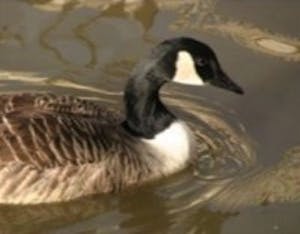
In Illinois there are several species of ticks that can be found, but only the American dog tick, lone star tick, blacklegged (deer) tick, brown dog tick and winter tick are likely to be encountered by people. Ticks are arachnids that wait for their host animals at the tips of shrubs and grasses, and will climb onto a host when brushed by a moving animal or person. Ticks cannot jump or fly, they only crawl. There are some preventative measures that can be taken to keep from getting tick bites when in natural areas:
- Wear long sleeved shirts and pants
- Apply insect repellent containing 10%-30% DEET to clothes
- Walk in the center of trails
- Check yourself and family members every 3 hours for ticks (ticks rarely attach to a host right away)
For more information on Illinois ticks, please visit idph.state.il.us/envhealth/pccommonticks
“Cicada Killer” wasps (Sphecius speciosus) can be seen in the dry sand areas (sandboxes, ballfields, etc) at some of our parks during the late summer season. While they are relatively harmless, their presence may alarm park visitors. The use of insecticides has proven ineffective on these pests and the district wishes to avoid spraying in high-use playground and park areas. The best course of action is to stay clear of these wasps should you encounter them. To learn more, click here.
Mosquitoes are a nuisance that can spread disease (not to mention a pesky annoyance at outdoor summer activities). Control of mosquitoes in Glenview is handled by the North Shore Mosquito Abatement District. Click here for more information about the work of this agency.
The Emerald Ash Borer (EAB) was first detected in North America in the Detroit, Michigan area in June 2002 and later that year in Ontario, Canada. Since then EAB has been found in Michigan, Ohio, Indiana, Maryland, Virginia and now Illinois (Click here to view a map of infested areas). Locally the EAB has been found on the North Shore in Wilmette and Evanston.
Glenview is inside the quarantine area for movement of brush, branches and tree materials. The natural spread of the EAB is about half of a mile or less annually; however, humans can greatly accelerate its spread. Firewood and log movement have been the primary means by which EAB is spread, so it is important when using firewood to purchase it from local vendors, and not transport it between areas.
EAB is native to Asia and is suspected to have arrived in this country in cargo utilizing wood packing material. In its native range, EAB attacks and kills trees that are weakened by stresses such as drought, disease, and mechanical injury. Unfortunately, in North America, EAB also attacks and kills healthy trees. This invasive pest is so aggressive that virtually all native ash trees are at risk, and trees may die within two to four years after they have been infested.
To date, over 15 million North American ash trees have been killed by the EAB. If the EAB is not contained, the devastation to our ash trees may be similar to that of the American elm trees that were decimated by Dutch Elm Disease. According to the Morton Arboretum Emerald Ash Borer website, the potential impact from the EAB in Illinois is significant. Ash trees account for six percent of forests state-wide and 20 percent of urban forests in communities in the northeastern part of the state or approximately 130 million ash trees.
EAB is a metallic green beetle about half the diameter of a penny and will be found on or around ash trees. Click here for an identification guide.
You know you have an EAB problem if you see:
- Snake-like or S-shaped paths (under the surface of the tree’s bark) and exit holes shaped like the letter D in the trunk or limbs
- Increased woodpecker activity
- Thinning canopy and yellow leaves
- Short vertical splits in the bark
- White colored larvae found under the bark
- Unusual leaves growing from the trunk and roots
For more detailed information on signs and symptoms of EAB infestation, click here.
The gypsy moth is a leaf-eating insect that feeds on trees and shrubs and is among the most destructive insects in the U. S. It is capable of stripping plants bare, leaving them vulnerable to secondary insect and disease attacks.

Mature females lay their eggs in late summer, but most damage occurs in May and June when the caterpillars feed on leaves. The caterpillars have five double rows of dark blue spots, followed by six double rows of brick red spots on their dorsal surface. They also have a thin yellow median stripe along the length of their back.
Although the caterpillars prefer oak leaves, they will eat from more than 500 kinds of shrubs and trees and thus are known to be the most destructive forest and landscape pests in the United States, according to the University of Illinois Extension Program officials. Though there is no known way to eradicate the gypsy moth infestation, there are steps homeowners can take to minimize gypsy moth damage before the moths are sighted. These include planting trees that are hearty and will thrive in your location, taking good care of the trees you have by watering well during dry season, fertilizing and pruning, and protecting tree bark from damage caused by mowers and trimmers.
Glenview is a quarantined area for the gypsy moth and egg masses have been spotted and destroyed at The Grove. If you see tan colored egg masses as shown in the photograph at left on tree bark or other surfaces on your property, they should be removed and destroyed immediately. Simply scrape them directly into a sturdy plastic bag, seal it, and throw it into the garbage, or scrape them directly into a container of soapy water to immediately kill the larvae, then transfer them into a sturdy plastic bag, seal it, and throw it into the garbage.
To find out more about the Gypsy Moth, click here.
